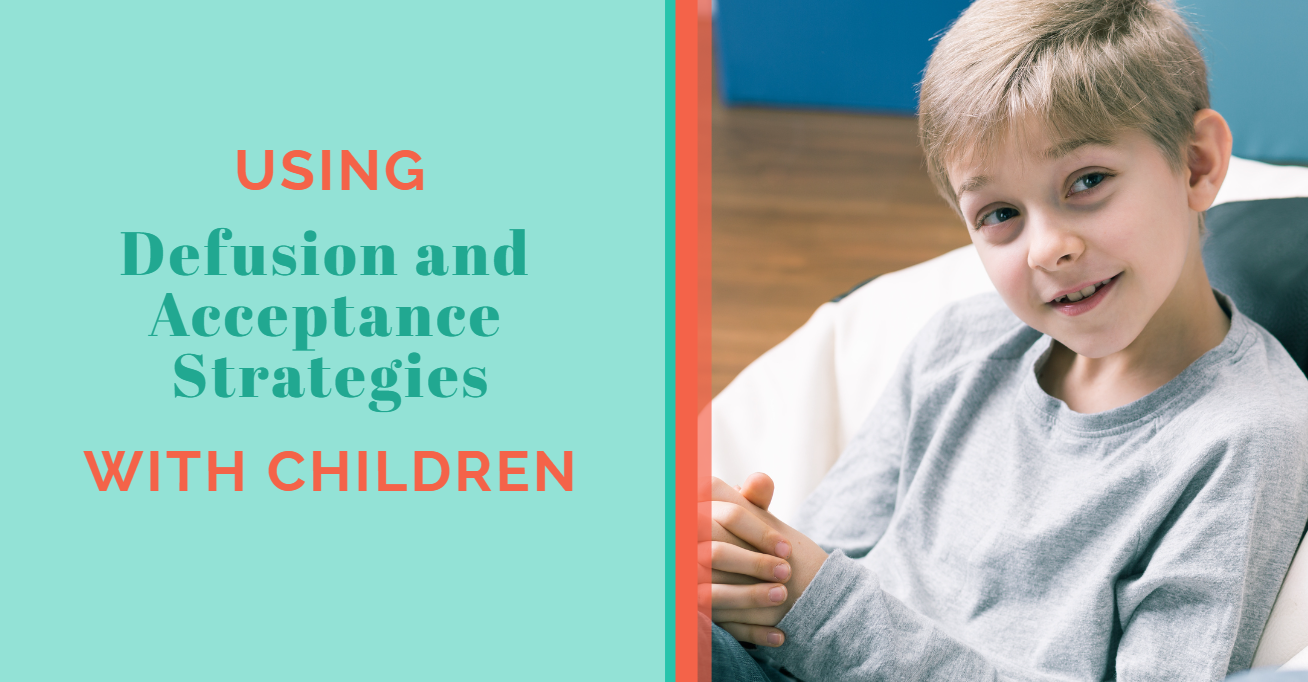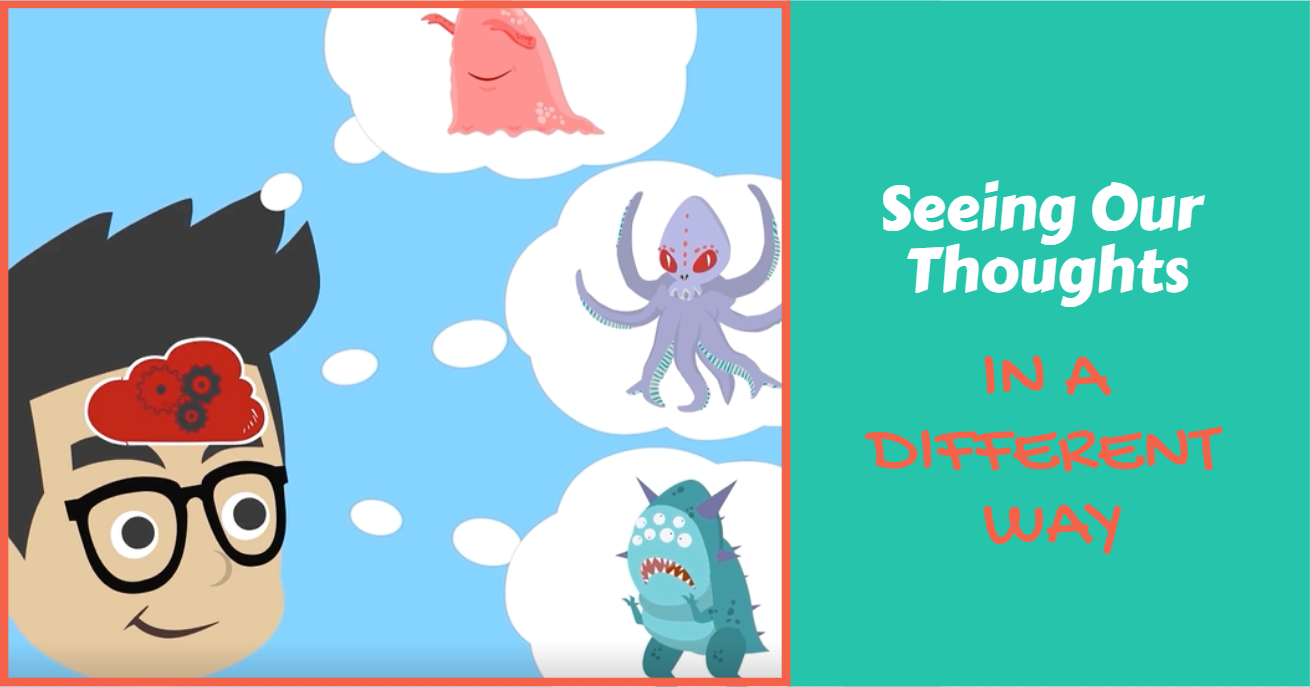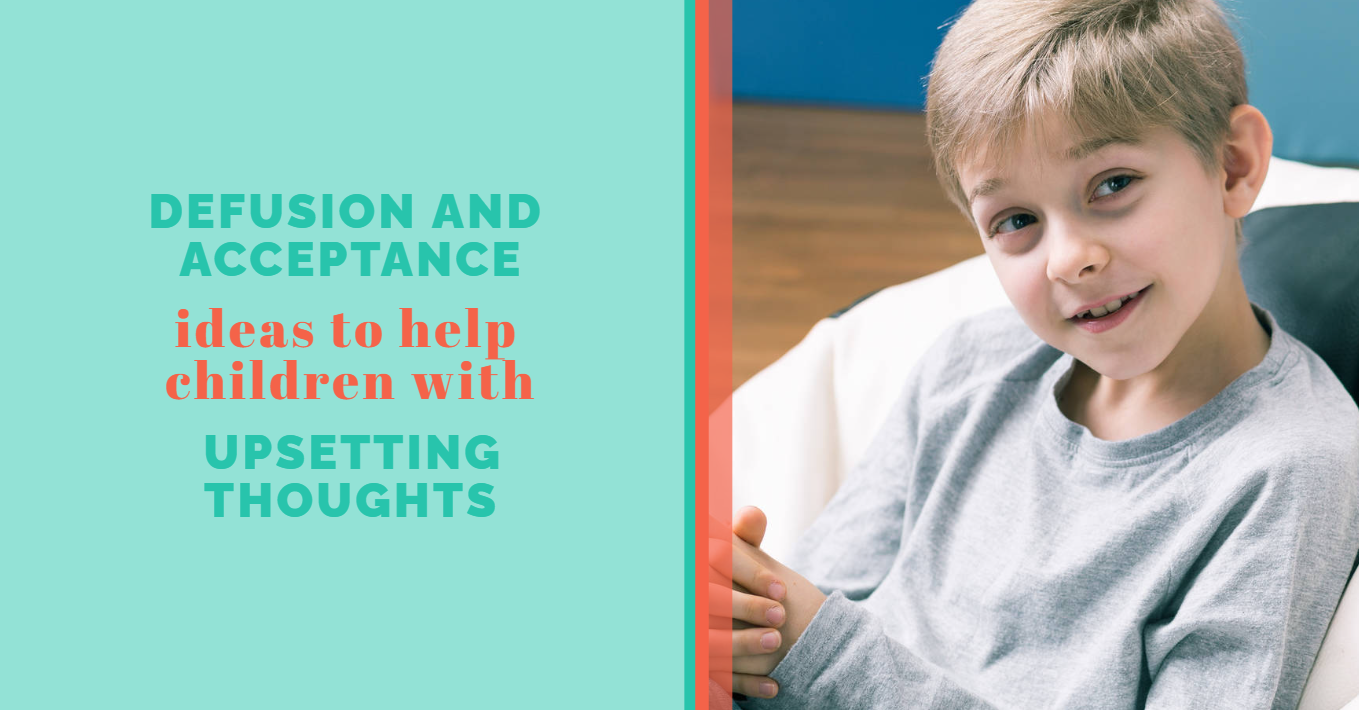Using Cognitive Defusion and Acceptance Techniques with Children and Adolescents
/Children and teens (like adults) often report thoughts, images and beliefs (internal experiences) which they find distressing (for example: “I’m horrible”; “people think I’m boring”; picturing themselves doing badly on a test).
There are multiple strategies and approaches for supporting young people to manage this type of distressing internal content. For example, a cognitive behavioural therapy (CBT) approach suggests we help young people understand that these thoughts/beliefs contain errors (thinking mistakes), support them to test or evaluate them and to develop alternative, more helpful or accurate thoughts and beliefs.
This approach (often called cognitive restructuring) is a key part of many CBT treatment protocols and has been positively evaluated in many randomized control trials for many diagnostic categories and problem areas – for both adults and children/teens.
An alternative strategy for understanding and managing distressing thoughts, images and beliefs is cognitive defusion and acceptance.
This strategy was first (or at least most famously) developed as part of an Acceptance and Commitment Therapy (ACT) approach (Hayes, 1999). ACT suggests distress occurs not a result of the content of thoughts, images and beliefs but instead because of the way people have learnt to automatically view, understand and respond to them. ACT therapists suggest that human learning processes (described by ‘Relational Frame Theory’) often lead to people viewing, understanding and responding to their internal experiences as if they were ’real things‘ or purely ‘literal events’ – this is called ‘cognitive fusion.’
Cognitive defusion on the other hand, is the process of viewing, understanding and responding to these thoughts, images and beliefs as harmless words, pictures and sensations which were created by and merely exist in the mind – and which are neither good, nor bad. Sometimes cognitive defusion is called ’stepping away‘ from thoughts/internal experiences or ’seeing them for what they are, not what they claim to be.’
For example, if a young person is cognitively fused with the thought: “I am horrible” - they react to and understand this thought as if it was not only true, but also real, awful, important and something which needs to be fixed. If they are defused from this thought, they see it as just a group of words which occur in their minds - predictably (for example, “my mind always says that when I am tired”), benignly and that this doesn’t need them to pay attention or do anything about it.
To help children/teens experience cognitive defusion with their thoughts and beliefs, ACT therapists often create exercises for them, or use metaphors in which they experience their thoughts and beliefs in different contexts to those in which they typically experience them. Using metaphors or experiences to help people defuse rather than just using verbal psycho-education (‘words’) is theorized to help people understand that all ’words‘ are just words – even those used by the therapist.
For example, to create a defusion experience for a young person about their thought: “I am horrible” we might get them to ‘sing’ this “I am horrible” sentence to the tune of the ’happy birthday song‘.
It is theorised that defusion can lead to acceptance of internal experiences and a reduction in (at least some of) the distress associated with the thoughts and more importantly, it can increase the young person’s ability to make flexible decisions about what they do when these thoughts occur. Using the example above, if a child/teen sings their “I am horrible” thought, they may experience a sense of defusion (this is just a thought) and therefore may be more able to not react or struggle with this thought – and instead accept it – and not spend a lot of time thinking about it or withdrawing from others.
Although defusion and acceptance strategies are usually associated with the ACT approach, ‘defusion-like’ and acceptance based techniques/philosophies have also been incorporated in other protocols. They have been referred to in the psychotherapy literature as early as 1916 when a psychologist called Titchener suggested that repeating a phrase over and over again leads to the phrase losing its meaning. Defusion like/acceptance exercises and concepts have also been included in other protocols such as meta cognitive therapy, mindfulness based therapy, traditional CBT, compassion based therapy and dialectical and behaviour therapy (in these protocols they have sometimes been referred to as ‘cognitive distancing’, ‘radical acceptance’ or ‘mindful observation of thoughts’).
Do defusion/acceptance strategies help young people experience less distress/improve function?
The evidence for the effectiveness of defusion and acceptance strategies primarily comes from randomised controlled trials evaluating the ACT approach to treating psychopathology. These RCTs have typically evaluated a complete ACT treatment protocol. These ACT protocols not only include defusion/acceptance strategies, but also strategies which help the young people identify their personal values, strategies which aim to increase young people’s ability to act in ways which are consistent with their values (similar to a behavioural activation and/or exposure based strategies) and those which focus on helping young people develop a self-compassionate, holistic view of oneself.
Although there have been more of these types of RCTs with adults, there have also been many with children or adolescents – and it has been theorised that ACT approaches may suit young people well given that often young people can be less literal than adults and more comfortable with metaphor and experiential therapy.
The conclusions drawn from these studies over the last 20 years are that ACT produces significant improvement for a range of diagnostic categories compared to treatment as usual (TAU). As a result, ACT is considered by most psychotherapy researchers as equally effective as CBT for anxiety and depression. A 2015 review of ACT studies with children/adolescents in particular similarly concluded that using ACT approaches usually results in improvement for this age group (noting as usual the methodological weaknesses inherent in most psychotherapy research).
As well as RCTs evaluating ACT, there have also been a small number of interesting studies (eg see Larsson, 2016) which have directly compared defusion/acceptance techniques specifically against cognitive restructuring techniques in the adult population. In these studies, both restructuring and defusion/acceptance outperform control conditions in reducing distress, believability and frequency of thoughts, however at least two studies have found defusion was more successful on some measures (for example reducing frequency of distressing thoughts).
Using defusion/acceptance exercises or metaphors with young people
There are many types of defusion and acceptance experiences that might be helpful for young people. Broadly speaking, exercises and metaphors which assist young people to defuse internal experiences may be those which help them experience and understand their thoughts, feelings and memories as common, understandable (given their experiences and/or human learning), predictable (and can be labelled), able to be added to or modified (but not necessarily removed) and unable to hurt us.
This means defusion/acceptance exercises might include:
Writing out thoughts/ memories/beliefs in different colours on paper
Saying these thoughts/ memories/beliefs repeatedly out loud in different pitches, volumes and accents
Imagining what other peoples (family/friends) thoughts/memories might be
Using labelling such as: “I’m just having a thought that….”, “my worry/mad monster is telling me….”, “my danger checker is busy making me ….”
Predicting the occurrence of thoughts/memories/beliefs (“my worry monster always…”, “my mad monsters get busy when….”
Drawing/writing out the understandable, human learning causes of distressing thoughts/feelings/memories (“the reason my brain says…is…”)
Imagery/metaphors to assist with defusion acceptance might include describing thoughts/feelings/memories/beliefs as:
Clouds passing by (can’t control the weather, but clouds can’t hurt you)
Toddler having a tantrum (you are in charge but they can be noisy)
Leaves floating down a stream (imagining distressing thoughts written on leaves which float by)
Example of a defusion exercise for children
Below is a script of a defusion exercise which might suit younger children. Of course this script would need to be adjusted to suit the situation and the child – including varying the language to suit a goal of assisting with defusion/acceptance for thoughts associated with anxiety or with frustration. For example, for children managing challenges related to anxiety, we might use the term ‘worry monsters’, and for those struggling with feelings of frustration, we might call them ‘mad monsters’.
The script would be accompanied by the therapist (and the child) drawing the various figures/concepts which accompany the words.
Sometimes we have lots of worry/mad monsters which float around us and tell us lots of worried/mad thoughts and give us lots of worried/mad feelings. Everyone has worry/mad monsters.
They hang around us telling us all the problems and things which can go wrong/things that are not fair.
What kind of worry /mad monsters do you have? (Support the child to identify thoughts which precede/are associated with distress).
It seems you have a “I might get hurt” worry monster. It seems you have a “I’m bad” worry monster. It seems you have a “Not fair” mad monster.
They boss us around and tell us what to do – like tell us to stay away from…./make us yell (support the child to identify any unhelpful behaviour they use after their distress)
They can be really loud – and so we try to make them go away by doing what they tell us.
But here’s an important thing to know.
When we take a close look at our worry/mad monsters, they are not as big and powerful as they seem.
They are just annoying little things which can’t actually hurt us. They are just like little buzzy mosquitos/flies/little loud toddlers.
We don’t have to do what they say after all!
And here is another thing to know about our worry/mad monsters:
They are not real, they are just things WE made in our brain.
And because we made them we can play around with them!
Let’s have a play. Let’s draw your “I am dumb” monster.
Now can you draw it with a silly hat on? How about with multi-colour socks?
Let’s imagine it with a very squeaky mouse voice. Can you say “I’m dumb” in a squeaky mouse voice?
Now you can see your worry/mad monsters are not big or powerful.
You can be the boss of them.
We can’t get rid of them, but that’s okay, they can come along with us while we still do the stuff that is important to us.
Shall we cut them out and put them in your pocket to take around with you today? (Cut out drawings of monsters for child to take home).
Although this has a childlike feel, it can be adapted to be used for adolescents without too many significant changes to the content (ACT therapists working with adults use very similar analogies). Some change in language might be useful - for example, using the words ‘anxiety’ or ‘anger’ rather than ‘worry’ and ‘mad’, or using the phrase ‘in charge’ rather than ‘the boss’.
Consolidating the understanding and usefulness of defusion/acceptance concepts
As always, it is important that we do not just introduce defusion/acceptance concepts to a young person, but go on to assist them to understand, use and consolidate this understanding into their daily lives. This might include taking the exercises/analogies above and asking the child/teen to practice these for homework – for example this might include:
Labelling activities – ask child to talk kindly to their worry monsters during the week: “hello I’m dumb worry monster, how are you today?”, and describe their anxiety to others using same labelling language, “Mum, I’ve got lots of worry monsters buzzing around me today”
Modifying activities – saying thoughts out loud for 5 minutes in different accents/volumes each day, writing out thoughts in different colours, drawing worry/mad monsters with modifications (items of clothing/funny expressions/different colours)
Predicting in advance – talk to caregiver about which mad monsters might turn up in which situations at school/in daily life and preparing for what to do when this happens
Using defusion/acceptance strategies within a broader approach
It is important to note that defusion/acceptance work was not designed by ACT therapists to be used in isolation, but instead to be incorporated into the broader approach described above (identification of values, a focus on increasing behaviours which are consistent with values, focus on a self-compassionate, holistic view of oneself).
Whether or not we are using defusion/acceptance strategies within an entire ACT protocol or using these strategies alongside therapeutic elements from other approaches, it is important to note that defusion/acceptance based strategies are unlikely to be appropriate in isolation.
As always, we will need to have a list of problem areas/treatment goals, theory about the causes of these (which might include cognitive fusion) and be designing a range of treatment elements which address these – with a strong focus on activation and behaviour change. This means defusion/acceptance strategies will sit within a broad approach rather than being used on their own.
Can defusion/acceptance strategies be used with cognitive restructuring?
Cognitive restructuring techniques (directly altering cognitive content) are seen by some therapists as inconsistent with defusion/acceptance techniques (stepping back from and accepting cognitive content) and therefore some therapists feel the two are not appropriate to be used with the same child/teen.
However, this may be unnecessarily rigid. We may be able to assist young people to use cognitive restructuring for some content and defusion/acceptance for other content. For example, it may be that some thoughts are more testable and therefore amenable to restructuring (“I will faint if I am away from Mum”) and some are less so (“I am horrible”) – and therefore can be defused from.
It may also be that some thoughts can be ’defused from‘ after they have been restructured to increase the young person’s ability to manage them. For example, a child/teen who has tested and restructured a thought such as “I will faint” a number of times and has lower belief in the thought, but is still bothered by it – might then benefit from a defusion/acceptance exercise.
If we are introducing both approaches, we might use language such as: “one way to cope with worry monsters is to see if they are really true” and “another way to cope with worry monsters is to play around with them and to notice that they can’t hurt us”. Using defusion/acceptance strategies when working with kids/teens with emotional or mental health challenges is likely to provide a useful and lasting perspective on managing distressing internal content and therefore worth considering when working with this age group.
Some key references:
Larsson, A., Hooper, N., Osborne, L. A., Bennett, P., & McHugh, L. (2016). Using Brief Cognitive Restructuring and Cognitive Defusion Techniques to Cope With Negative Thoughts. Behavior Modification, 40(3), 452–482. https://doi.org/10.1177/0145445515621488
Krafft, J., Klimczak, K.S. & Levin, M.E. Effects of Cognitive Restructuring and Defusion for Coping with Difficult Thoughts in a Predominantly White Female College Student Sample. Cogn Ther Res 46, 86–94 (2022). https://doi.org/10.1007/s10608-021-10242-4
Swain, J, Hancock, K, Dixon, A & Bowman, J 2015, ‘Acceptance and Commitment Therapy for children: A systematic review of intervention studies’, Journal of Contextual Behavioral Science, vol. 4, no. 2, pp. 73–85.
In addition, if you work with younger children (aged 4-11), you might like to access our new Calm Kid Pro videos on this topic (one for professionals, one for children and one for parents/carers). Click below for more information about Calm Kid Pro.




